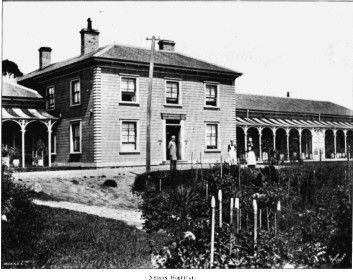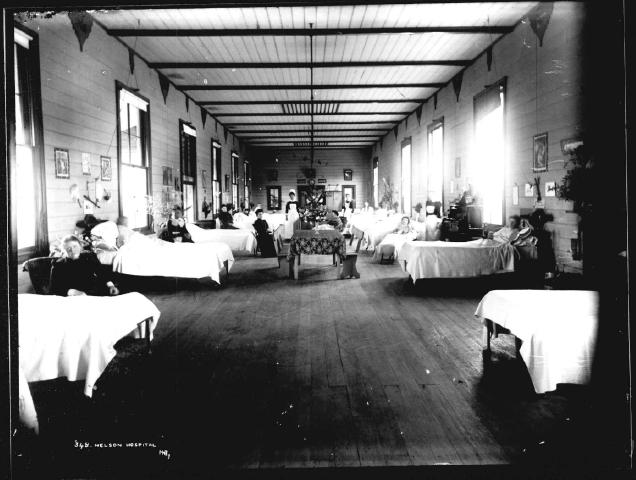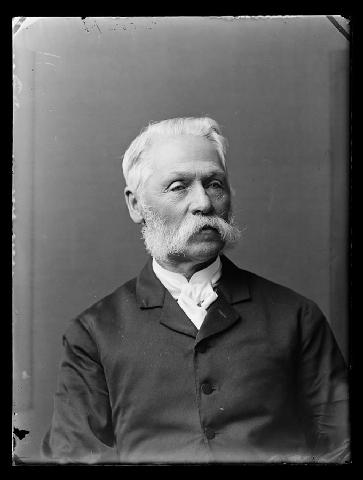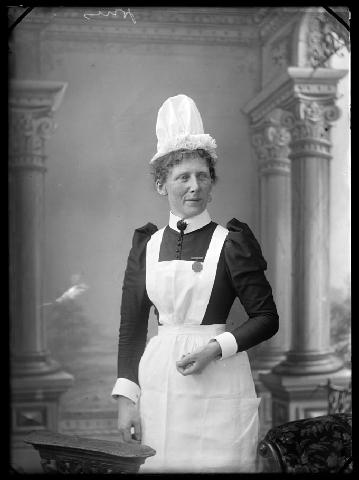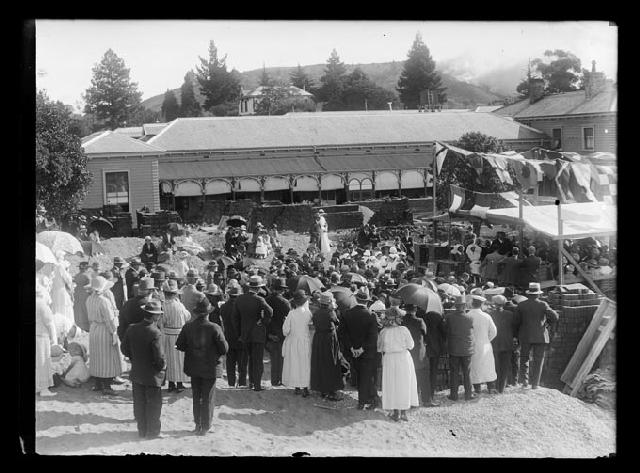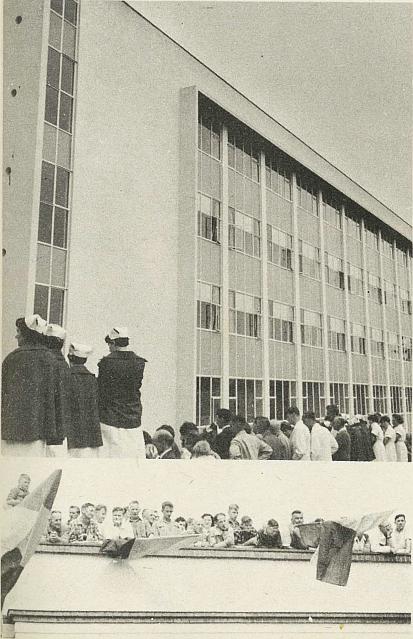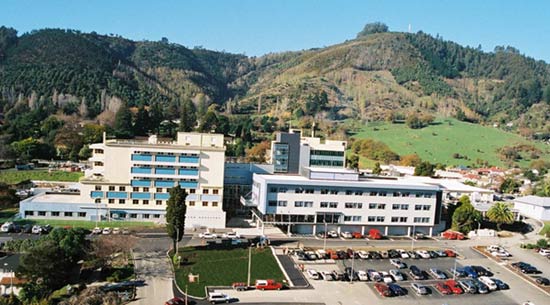Nelson Hospital
The development of health services Nelson’s first hospital was a lean-to attached to the barracks built on Piki Mai/ Church Hill in the 1840s. Various private cottage hospitals provided rudimentary medical services in the 19th Century.
The development of health services
Nelson’s first hospital was a lean-to attached to the barracks built on Piki Mai/ Church Hill in the 1840s. Various private cottage hospitals provided rudimentary medical services in the 19th Century. The first permanent hospital was situated in a two-storey house on the corner of Examiner and Rutherford Streets.1 This hospital could accommodate 11-12 patients but was so borer-ridden that it was eventually deliberately burnt down.2
The foundation stone ceremony for a new hospital took place on April 1867, when two bottles of dominion coins, copies of the latest editions of the Examiner, Colonist and Nelson Mail and a parchment scroll were buried at the site - a seven acre block of land belonging to the Government on Waimea Road, where the current hospital is located. The building opened in July 1869. Built at a cost of £2500, it was designed by architect Mr Blackett as a two-story wooden building with two large wards accommodating 45 patients (one for men, one for women), an overflow ward, two isolation rooms, an operating room and various other rooms and facilities for staff and patients.3 The hospital also had several shelters for TB patients - they were open to the air with no heating, but many patients did well with this sun and fresh air treatment.4
The management of the hospital was changed from private medical practitioners of the city managing medical care and supervision, to a surgeon who was stationed in the hospital devoting himself to the care of the patients in the hospital itself. The out-patients and inmates of the Taranaki Buildings, Gaol, Lunatic and Police were also under his care. The hospital committee consisting of Messrs. Rough, Greenfield, Burn, Barnicoat and Renwick appointed Dr Boor as resident surgeon, Dr Squires as consulting physician and Dr Farrelle as consulting surgeon.
The first matron of the hospital was Miss Susan Dalton, a capable looking English woman, weighing 18 stone who was said to do the work of 15 nurses.5
The Nelson Hospital Board took over the management of the hospital from the committee in November 1885. In 1886, a report was tabled in the House of Representatives by Dr Grabham, Inspector General of Hospitals and Asylums. He visited Nelson Hospital on 8 December 1885 and said it presented an appearance of homeliness and comfort without some of the luxuries found in other better endowed colonial hospitals: “which is often due to private gifts and individual efforts rather than to expenditure of public money.”
Dr Grabham suggested some improvements: “The present arrangements for giving a hot bath are both primitive and inconvenient, the bathroom being at some distance from the wards, and the furnace in a detached building…I beg to suggest that one of the modern contrivances for heating by means of gas be adopted.”6
Dr Grabham’s report praised the hospital’s resident medical officer, Dr Boor. In 1885, the outgoing hospital committee recorded their appreciation of Dr Boor’s long service and gave testimony to ’the skill, kindness and courtesy invariably shown by that gentleman.”7
The 19th century nurse was a maid of all work, on duty for long hours and poorly paid. In 1897, Nelson Hospital became a training school for nurses. The 1904 Nurses and Midwives Registration Act introduced three years of training for general nurses and two years training for maternity nurses.8 In 1914-16, the first dedicated Nurses' Home, later known as Dalton House, designed by A.R. Griffin, was built.9
Until 1925, all births were attended in private hospitals or at people’s homes. If there were complications, a doctor would be called. It was not uncommon for a doctor ‘to be faced with a breech presentation, with an inexperienced nurse in attendance with instruments boiling in a pot over an open fire and some illumination provided by one or two candles.”10
A new hospital, opened in 1925, featured an innovation - a maternity ward. Designed by Arthur Griffin, it also had a new modern theatre, anaesthetic room, x-ray plant and a physiotherapy department in the basement. By the 1930s, the resident medical staff consisted of a medical superintendent and a house surgeon. The superintendent operated four to five mornings each week and was assisted by a local GP - usually the doctor who had visited the patient at his or her home.11
The Inangahua and Murchison earthquakes both caused severe structural damage to the hospital buildings. Following the 1926 earthquake, the hospital was steel reinforced at a cost of £7400.12
The current Nelson Hospital buildings all date from post World War II. The new George Manson block was opened by Governor General, Lord Cobham in October 1960. The £1,359,000 building project included new wards, operating theatres, administrative offices, x-ray and physiotherapy departments and a boiler house. A new nurses’ home cost £477,000.13
Nurses and patients alike would have been pleased with a change in daily routine in 1961, which saw patients awakened later than previously. The day swung into action at 7am with breakfast from 7.30am. “Not only has this change pleased the patients who benefited directly from the hours of rest, but also the nursing staff who have been unanimous that it was indeed a change for the better.”14
2015 (updated 2024)
Story by: Joy Stephens
Sources
- Wilson, J (2011) Thematic historical overview of Nelson City. [Written by John Wilson for the Nelson City Council as part of the Nelson Heritage Inventory Project] Nelson: Nelson City Council, p.99
- Low, D. C. (1972) Salute to the scalpel : a medical history of the Nelson Province : fifty years of experience as a medical superintendent, part time surgeon, chairman of the Nelson Hospital Board, and general practice in Nelson city. [Nelson] : D. Low, pp.13-15
- Nelson Hospital. In The Cyclopedia of New Zealand [Nelson, Marlborough & Westland Provincial Districts] (1906). Christchurch: The Cyclopedia Company, Limited, p.60
- Low, pp.18-19.
- Low, p.16
- Grabham, Dr (1886) Hospitals in New Zealand (report on), by Dr. Grabham, Inspector-General of hospitals and asylums. Appendix to the Journals of the House of Representatives, 1886 Session I, H-09
- The Nelson Hospital (1885, November 7) Colonist, p.3
- Low, p.98
- Arthur Griffin and Nelson Hospital (TheProw)
- Low, p.36
- Low, p.28
- Earthquake damage (1930, January 14) New Zealand Herald, p.10
- New hospital block opened by Governor General (1960, November 12) Nelson PhotoNews, p.10:
http://photonews.org.nz/nelson/issue/NPN1_19601112/t1-body-d10.html - Shirtliff, N. (1961) A break from tradition. New Zealand nursing journal. v.54 n.10:pp.4-5
Further Sources
Books
- Blampied, R. A. (1968) The trail of a pioneer : being an account of the pilgrimage of James Barton, 1820-1910, for 33 years attendant and dispenser at the Nelson Public Hospital, for 66 years pioneer member and leader of the Church of Christ, Nelson. Nelson [N.Z.] : Printed by R.W. Stiles & Co.
http://www.worldcat.org/oclc/154311767 - Evaluation and planning of services (1985) Nelson: Nelson Hospital Board [held Nelson Public Libraries]
- Low, D. C. (1972) Salute to the scalpel : a medical history of the Nelson Province : fifty years of experience as a medical superintendent, part time surgeon, chairman of the Nelson Hospital Board, and general practice in Nelson city. [Nelson] : D. Low
http://www.worldcat.org/oclc/153710818 - Maclean, H. (1932) Nursing in New Zealand: Nursing in New Zealand: History and Reminiscences. [Zealand]: Toland Printing Company, Retrieved from NZETC:
http://nzetc.victoria.ac.nz/tm/scholarly/tei-MacNurs-t1-body-d19.html - Nicholls, H. (2000) "Nuuuurse" the story of the Nelson Hospital School of Nursing. Nelson: [The Reunion Committee]
http://www.worldcat.org/oclc/155579841 - Wilson, J (2011). Thematic historical overview of Nelson City.[Written by John Wilson for the Nelson City Council as part of the Nelson Heritage Inventory Project] Nelson: Nelson City Council, p.99:
http://www.nelsoncitycouncil.co.nz/assets/About-nelson/downloads/1176312-thematic-historical-overview-of-nelson-city-OCT2011.pdf
Newspapers
- The chapel at Nelson Hospital (1964, November) New Zealand nursing journal. v.57 n.11:p.29
- Five decades of nursing come to an end (2005, March) Kai Tiaki : Nursing New Zealand. v.11 n.2:p.8
- Haley, A. (1998) Alexandra Home: The Early Years Remembered.
http://nzetc.victoria.ac.nz/tm/scholarly/tei-NHSJ06_02-t1-body1-d2.html - Liell, J (Oct 2004) Archiving hospital records : an account of the listing of records held by the Nelson Marlborough District Health Board. Archifacts; p.59-65
- The new face of hospital care in Nelson (2003) New Zealand Health & Hospital. v.55 n.3:p.8-11
- O’Connor, T. (Dec 1994/Jan 1995) A nursing career ends. Nursing New Zealand; v.2 n.11:p.28-29
- Shirtliff, N. (1961) A break from tradition. New Zealand nursing journal. v.54 n.10:p.4-5
- Squires, Rev. T. (2015) Nelson's first medical coroner. Nelson Historical Society Journal. 8(1), pp31-35
On Papers Past
- Nelson Provincial Council (1869, May 13) Nelson Evening Mail:
http://paperspast.natlib.govt.nz/cgi-bin/paperspast?a=d&cl=search&d=NEM18690513.2.5 - Advertisements [Nelson Hospital] (1883, November 29) Colonist, p.2
http://paperspast.natlib.govt.nz/cgi-bin/paperspast?a=d&d=NEM18830630.2.10 - The Nelson hospital (1885, November 7) Colonist, p.3
http://paperspast.natlib.govt.nz/cgi-bin/paperspast?a=d&d=TC18851107.2.8 - The new hospital (1915, September 2) The Colonist, p.8
http://paperspast.natlib.govt.nz/cgi-bin/paperspast?a=d&cl=search&d=TC19150902.2.36.3 - Dental ward for new hospital (1916, July 15) Colonist, p.7
http://paperspast.natlib.govt.nz/cgi-bin/paperspast?a=d&d=TC19160705.2.52.1 - The new hospital (1918, April 11) Nelson Evening Mail, p.3
http://paperspast.natlib.govt.nz/cgi-bin/paperspast?a=d&cl=search&d=NEM19180411.2.22 - Hospital facilities (1926, February 22) New Zealand Herald, p.10
http://paperspast.natlib.govt.nz/cgi-bin/paperspast?a=d&d=NZH19260222.2.104 - Earthquake damage (1930 January 14) New Zealand Herald, p.10
http://paperspast.natlib.govt.nz/cgi-bin/paperspast?a=d&d=NZH19300114.2.97 - Hospital X-ray plant (1930, June 6) New Zealand Herald, p. 15
http://paperspast.natlib.govt.nz/cgi-bin/paperspast?a=d&d=NZH19300606.2.138
Websites
- Beer, E. (2012, September 28) Trust battles to save historic building. Nelson Mail, on Stuff:
http://www.stuff.co.nz/nelson-mail/news/7741551/Trust-battles-to-save-historic-building - Charitable Institutions (1906) In The Cyclopedia of New Zealand [Nelson, Marlborough & Westland Provincial Districts]. Retrieved from NZETC:
http://nzetc.victoria.ac.nz//tm/scholarly/tei-Cyc05Cycl-t1-body1-d1-d1-d12.html - History. Nelson Marlborough District Health Board. Retrieved from NMDHB:
http://www.nmdhb.govt.nz/NMDHBHistory.aspx - Medical. (1906) In The Cyclopedia of New Zealand [Nelson, Marlborough & Westland Provincial Districts]. Retrieved from NZETC:
http://nzetc.victoria.ac.nz//tm/scholarly/tei-Cyc05Cycl-t1-body1-d1-d1-d19.html - Nelson Hospital. In The Cyclopedia of New Zealand [Nelson, Marlborough & Westland Provincial Districts] (1906). Christchurch: The Cyclopedia Company, Limited, p.60.
http://nzetc.victoria.ac.nz/tm/scholarly/tei-Cyc05Cycl-t1-body1-d1-d1-d12.html#Cyc05Cycl-fig-Cyc05Cycl059a - Nelson Marlborough District Health Board (NMDHB) history:
http://www.nmdhb.govt.nz/NMDHBHistory.aspx - New hospital block opened by Governor General (1960, November 12) Nelson Photo News, p.10:
http://photonews.org.nz/nelson/issue/NPN1_19601112/t1-body-d10.html - Oliver, J. (2013) 'Jamieson, James Peter Speid', from the Dictionary of New Zealand Biography. Te Ara - the Encyclopedia of New Zealand, updated 23-Oct-2013.
http://www.TeAra.govt.nz/en/biographies/4j3/jamieson-james-peter-speid
Maps
- Hospitals in New Zealand (report on), by Dr. Grabham, Inspector-General of hospitals and asylums. Appendix to the Journals of the House of Representatives, 1886 Session I, H-09:
http://atojs.natlib.govt.nz/cgi-bin/atojs?a=d&cl=search&d=AJHR1886-I.2.3.3.16
